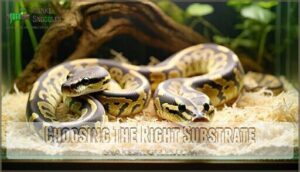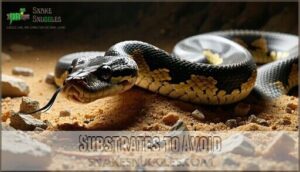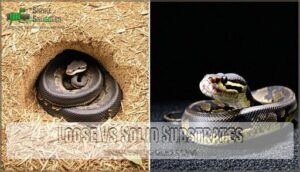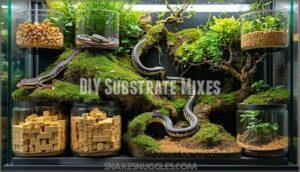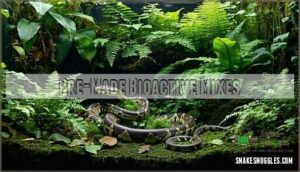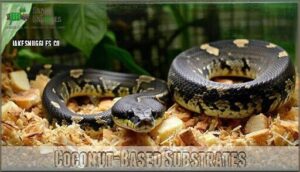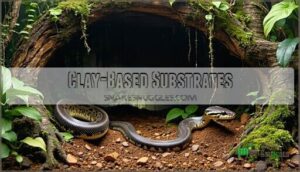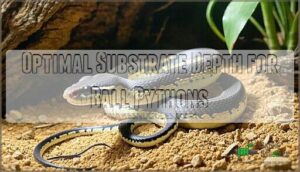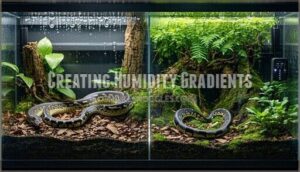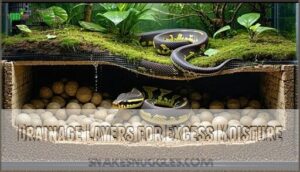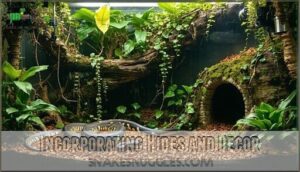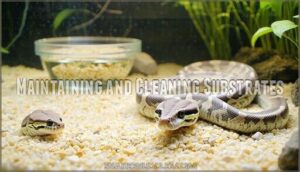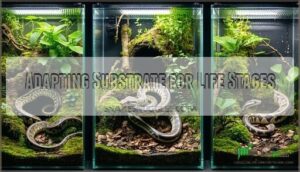This site is supported by our readers. We may earn a commission, at no cost to you, if you purchase through links.
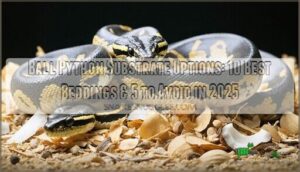 In the context of ball python substrate options, you’ve got plenty of great choices to keep your snake comfy and healthy.
In the context of ball python substrate options, you’ve got plenty of great choices to keep your snake comfy and healthy.
Coconut fiber is a favorite because it holds humidity well, while aspen shavings let them burrow like a champ. Reptile bark and bioactive mixes are also excellent if you want a natural look.
Paper towels or reptile carpets are low-maintenance if simplicity is your thing. Just steer clear of sand, pine, or cedar—they’re no good for your snake’s health.
Remember, picking the right bedding isn’t just about looks—it’s their home! Want to optimize comfort? Layering might be your next move.
Table Of Contents
- Key Takeaways
- Choosing The Right Substrate
- Substrates to Avoid
- Loose Vs Solid Substrates
- Bioactive Substrates
- DIY Substrate Mixes
- Commercial Substrate Options
- Substrate Depth and Layering
- Maintaining and Cleaning Substrates
- Adapting Substrate for Life Stages
- Frequently Asked Questions (FAQs)
- What is the best substrate for a ball python?
- What is a bioactive substrate for a ball python enclosure?
- How much does a ball python substrate cost?
- Can you use a ball python substrate for shedding?
- How do you make a bioactive substrate for a Python?
- Can a ball python eat substrate?
- How Often Should I Replace the Substrate for My Ball Python?
- How Do I Know Which Substrate is Best for My Ball Python?
- Are There Any Substrates That Need to Be Avoided for Ball Pythons?
- How Do I Know if My Ball Python is Comfortable in Its Substrate?
- Conclusion
Key Takeaways
- Choose substrates like coconut fiber or cypress mulch for humidity control, burrowing, and a natural habitat.
- Avoid harmful options like sand, cedar, or pine shavings, which can cause impaction or respiratory problems.
- Spot clean daily to remove waste, replace loose substrates monthly, and sanitize for a healthy environment.
- Bioactive setups with soil, bugs, and moss mimic wild habitats and reduce cleaning with a self-sustaining ecosystem.
Choosing The Right Substrate
You’ll need to keep in mind your ball python’s specific needs when selecting substrate, as the right bedding affects humidity, burrowing behavior, and overall health.
The right substrate shapes your ball python’s world, balancing humidity, comfort, and natural instincts for a thriving, happy snake.
Your choice will directly impact your snake’s comfort and well-being, much like how you wouldn’t want to sleep on a bed of rocks yourself, which is related to the concept of comfort.
Importance of Substrate for Ball Pythons
The right substrate for your ball python isn’t just an aesthetic choice—it’s fundamental to their wellbeing.
Proper bedding directly impacts your snake’s health and happiness in captivity.
Here’s why substrate matters:
- Health Implications – Prevents scale rot by managing moisture levels
- Behavioral Enrichment – Supports natural burrowing instincts
- Humidity Control – Maintains proper respiratory function
- Waste Management – Absorbs waste and controls odor
- Thermoregulation Needs – Creates temperature gradients essential for bodily functions
Mimicking Natural Habitat
To create a slice of African wilderness in your ball python’s enclosure, choosing substrates that mimic their natural habitat is essential for their psychological wellbeing.
Creating a natural habitat for your ball python enriches their psychological wellbeing, encouraging confidence and natural behaviors in a secure, stimulating environment.
Natural substrates support instinctive behaviors while providing sensory stimulation.
Selecting appropriate substrates, like aspen shavings or coconut fiber, is key for maintaining snake health.
| Substrate Type | Natural Behavior Support | Habitat Complexity |
|---|---|---|
| Coconut husk | Excellent burrowing | High texture variety |
| Bioactive setup | Natural foraging | Mimics forest floor |
| Cypress mulch | Supports exploration | Varied topography |
When you recreate these earthy environments with naturalistic snake substrates, you’re giving your pet environmental enrichment that satisfies their innate needs. Your ball python will thank you by displaying more confident, natural behaviors, which is a result of providing them with the right substrates to thrive.
Humidity Regulation
Humidity maintenance forms the backbone of successful ball python care, particularly when selecting appropriate substrates for their enclosure.
The right substrate doesn’t just house your snake—it actively regulates its microclimate.
- Coconut fiber retains moisture excellently, releasing it gradually for consistent humidity levels
- Cypress mulch naturally resists mold while maintaining ideal substrate moisture levels
- Sphagnum moss can be mixed in to create humidity pockets, essential during shedding cycles
- Strategic hydrometer placement helps monitor different enclosure zones
- Proper enclosure ventilation prevents condensation while preserving humidity
You’ll want substrates that work like natural sponges, absorbing water during mistings and slowly releasing moisture throughout the day.
This balance supports healthy shedding success and respiratory function.
Remember, ball python substrate choices directly impact humidity regulation—aim for 50-60% humidity generally, increasing to 65-70% during shedding periods.
Burrowing Behavior Support
A proper ball python substrate supports their natural burrowing behavior, keeping them active and stress-free.
Loose, naturalistic substrates like coconut fiber or bioactive soil are the best substrate for burrowing, as they mimic their wild environment.
Aim for a substrate depth of 3-4 inches to allow tunneling techniques and natural exploration.
Partially bury hides to encourage digging while adding enclosure enrichment.
- Watch them burrow and peek out—it’s adorable!
- **A burrowing snake is a happy snake.
- **Natural behaviors reduce stress and improve health.
Substrate density matters too—soft, loose materials guarantee safety and comfort.
Waste Management
Beyond supporting burrowing, your substrate plays a key role in waste management.
Good ball python substrate handles waste effectively, controlling odors and making cleaning easier for you.
For efficient odor absorption, coconut-based substrates excel, while bioactive setups employ cleanup crews that naturally process waste.
You’ll need to perform regular spot cleaning of visible waste, with full replacement every 1-2 months depending on your choice.
Proper waste disposal keeps your snake healthy and your enclosure smelling fresh, which is crucial for maintaining a clean and healthy environment.
Temperature Gradient Maintenance
Throughout the day, your substrate plays a vital role in maintaining proper temperature gradients for your ball python.
Some materials excel at this important job:
- Coconut husk and cypress mulch offer excellent heat retention properties, creating ideal temperature zones
- Deep substrate (3-4 inches) allows for better heat distribution from heating pads
- Proper thermostat probe location between substrate and heat mat guarantees accurate readings
- Layered substrate approaches help maintain basking spot temps while preserving humidity
Avoid reptile carpet—it’s terrible at temperature management. Instead, choose substrates that create a natural thermal highway your snake can navigate.
Substrates to Avoid
You’ll want to avoid certain substrates that can harm your ball python’s health, including sand, pine shavings, cedar, gravel, and artificial carpet.
These materials can cause serious problems like respiratory issues, impaction, or injury, and they’re simply not worth the risk when so many safer alternatives exist, providing a better environment for your pet’s health.
Sand
After learning about proper substrate selection, let’s examine why sand should stay out of your ball python’s enclosure.
Sand is one of the worst substrate choices for ball pythons due to:
- Severe impaction risks when accidentally ingested during feeding
- Respiratory irritation from fine dust particles
- Poor humidity retention leading to dehydration issues
- Abrasive texture that irritates your snake’s sensitive skin
Even desert-dwelling snakes rarely live on pure sand in the wild.
Your ball python deserves safer alternatives that won’t compromise their health.
Pine and Cedar Shavings
Unlike sand, pine and cedar shavings present a hidden danger you can’t see. These wood products release toxic oils (phenols) that can devastate your ball python’s health.
When your snake breathes these aromatic dangers, they can develop severe respiratory issues within days or weeks.
Even kiln-dried pine isn’t completely safe. Historical usage doesn’t make these harmful wood shavings appropriate—we simply know better now.
Safe alternatives include:
- Coconut fiber (excellent humidity retention)
- Cypress mulch (naturally antimicrobial)
- Paper substrates (easy cleaning)
Don’t risk your snake’s health for a pleasant smell or cheaper price. Your ball python can’t tell you when they’re suffering, so it’s up to you to choose wisely.
Gravel
While pine and cedar shavings release harmful oils, gravel presents its own dangers for ball pythons.
These small stones pose serious gravel impaction risks if accidentally swallowed during feeding.
Their abrasiveness concerns can also damage your snake’s sensitive scales and underbelly.
Gravel’s poor absorption qualities fail to maintain necessary humidity levels, and bacteria harboring between stones creates unhygienic conditions.
Though visually appealing, these smooth pebbles offer no burrowing opportunities and can’t be digested if ingested.
Always prioritize your python’s safety over decoration with proper substrate alternatives.
Artificial Outdoor Carpet
Artificial outdoor carpet might seem like a simple ball python substrate, but it’s loaded with safety hazards.
It’s notorious for chemical leaching and quickly becomes a bacteria harbor, even with frequent cleaning. Plus, its durability concerns make it a poor long-term choice.
Here’s why it’s risky for your snake enclosure substrate:
- Traps waste, making cleaning difficult and unsanitary
- Breaks down after repeated washes, reducing lifespan
- Fibers encourage mold and bacteria growth
- Chemicals can irritate your ball python’s sensitive skin
Instead, explore safer reptile substrate options like coconut husk or paper towels for your snake enclosure.
Loose Vs Solid Substrates
Choosing between loose and solid substrates depends on your ball python’s needs and your care routine.
Loose options support natural behaviors like burrowing, while solid ones simplify cleaning and reduce ingestion risks.
Benefits of Loose Substrates
Loose substrates are a fantastic way to mimic a ball python’s natural habitat while supporting essential needs like humidity retention and burrowing behavior.
They encourage natural behaviors, provide enrichment, and help with waste concealment. Plus, they’re great for thermoregulation support, creating a comfortable environment.
Here’s a quick comparison:
| Substrate Type | Benefits | Care Level |
|---|---|---|
| Coconut Fiber | High burrowing, excellent humidity | Medium |
| Bio-Active Mix | Natural cleanup crew, perfect enrichment | High |
| Forest Floor | Great waste absorption, temperature control | Low |
Loose substrates truly enrich your snake’s world and offer a way to support their natural behaviors, making them a great choice for ball python owners.
They provide a comfortable environment and help with essential needs, making them a valuable addition to any snake enclosure.
Benefits of Solid Substrates
Solid substrates are a no-brainer if you’re after simplicity and practicality for your ball python.
They’re easy to clean, cost-effective, and perfect for quarantine setups or hatchling enclosures. Spot cleaning? A breeze—just swap out soiled sections. Plus, pests like mites have nowhere to hide, keeping your snake safer.
Here’s a quick breakdown:
| Feature | Benefit | Why It Matters |
|---|---|---|
| Easy Cleaning | Saves time | Focus on your python’s care |
| Reduced Impaction | No loose bits to ingest | Prevents health issues |
| Quarantine Friendly | Simplifies monitoring | Ideal for sick or new snakes |
| Cost Effective | Budget-friendly materials |
Long-term savings.
Solid substrates like paper towels are also great for preventing scale rot and maintaining humidity control.
Choosing The Right Type
Choosing the best snake bedding depends on your ball python’s needs and your lifestyle.
Loose substrates excel at humidity control and support burrowing behavior but may pose impaction risks.
Solid options are budget-friendly and easy to clean but limit exploration.
Here’s a quick snake substrate guide:
| Feature | Loose Substrates | Solid Substrates |
|---|---|---|
| Cost | Higher upfront | Budget-friendly |
| Maintenance | Spot clean weekly | Quick daily cleaning |
| Humidity Needs | Excellent retention | Limited |
| Burrowing Behavior | Encourages digging | Restricts |
| Substrate Safety | Impaction risks exist | Safer for ingestion |
Bioactive Substrates
If you’re looking to create a natural, self-sustaining setup for your ball python, bioactive substrates are a fantastic option.
They support humidity control, burrowing, and even waste breakdown, making maintenance easier and your snake’s habitat healthier.
Creating a Living Ecosystem
Imagine your ball python living in a thriving, self-sustaining habitat.
A bioactive substrate setup uses bioactive soil, leaf litter, and beneficial organisms like springtails and isopods to handle waste decomposition and maintain ecosystem balance.
This naturalistic approach supports ecosystem sustainability and self-regulation while mimicking wild environments.
It’s like having a hidden cleaning crew, ensuring your snake enjoys the naturalistic benefits of a clean, balanced home.
Benefits of Bioactive Setups
A bioactive substrate setup transforms your ball python’s enclosure into a thriving mini-ecosystem.
It supports natural behaviors like burrowing while promoting humidity regulation and ecosystem sustainability.
Beneficial organisms in the bioactive soil handle waste decomposition, reducing cleaning tasks for you, creating a self-cleaning terrarium, which is like having a thriving mini-ecosystem that mimics the wild environment.
This setup creates a healthier and more enriching environment for your snake, plus, reduced cleaning means more time to enjoy watching your python explore its naturalistic habitat—win-win for both you and your scaly friend!
Essential Components of Bioactive Substrates
Building a bioactive substrate setup is like crafting a self-sustaining ecosystem for your ball python.
Here’s what you need:
- Drainage Layer: Prevents waterlogging and keeps moisture control in check.
- Soil Composition: A nutrient-rich mix supports plant selection and promotes substrate mold prevention.
- Leaf Litter and Organic Matter: Encourages beneficial organisms like microorganisms to thrive, aiding waste breakdown.
These layers create a balanced habitat, keeping your snake cozy and your enclosure naturally clean.
Proper ventilation is key to preventing humidity imbalances.
Microorganism and Invertebrate Populations
Your terrarium’s ecosystem thrives with beneficial organisms like isopods and springtails.
These tiny workers handle waste decomposition, maintain soil health, and keep a natural microbe balance.
Acting as your snake’s cleanup crew, they munch on organic debris, aerate the substrate, and even assist with population control of pests.
By supporting ecosystem balance, these invertebrates guarantee your bioactive setup stays clean and functional, creating a healthier, more natural environment for your ball python.
DIY Substrate Mixes
Creating your own substrate mix lets you control humidity, texture, and safety for your ball python’s enclosure.
It’s easier than you think and can save you money while keeping your pet happy and healthy.
Tropical Mix Recipe
For the perfect tropical mix, you’ll need:
- 40% organic topsoil.
- 40% ReptiSoil.
- 20% play sand.
This blend’s excellent for humidity levels, burrowing, and supporting a cozy environment for your ball python.
Add plants or invertebrates later to create a thriving ecosystem. It’s easier on your wallet than pre-made substrates, too.
Regular spot-cleaning and full replacements every few months will keep the habitat clean, fresh, and snake-approved!
Forest Floor Blend
A Forest Floor Blend creates a cozy, natural environment for your ball python while keeping humidity in check.
This bioactive substrate mimics the wild and offers excellent Enrichment Value.
Here’s your mix:
- Cypress mulch: A sturdy base for structure.
- Coconut fiber: Boosts Moisture Levels and humidity control.
- Sphagnum moss: Locks in moisture for a humid microclimate.
- Leaf litter: Adds an authentic forest touch and hides for exploring.
This blend balances cost and function, making it a top choice for forest floor mixes. Your snake will love this earthy retreat!
Arid Environment Substrate
For a proper arid environment substrate, mix 50% play sand, 30% organic topsoil, and 20% excavator clay.
This blend supports burrowing, temperature control, and soil ecology while addressing humidity concerns.
Light misting and a humid hide help during shedding.
Avoid impaction risks by feeding outside the enclosure.
Adding hardy plant choices, like succulents, can enhance aesthetics while maintaining the desert vibe.
Customizing Substrate for Individual Needs
Every ball python has unique needs, so customizing their substrate is a smart move. Think about their individual humidity, burrowing needs, and activity levels to create the ideal mix.
A younger python might thrive with coconut fiber and sphagnum moss for humidity control, while older ones may enjoy organic topsoil for natural burrowing.
Here’s a quick recipe guide:
- Coconut fiber for a soft, natural substrate feel.
- Sphagnum moss to aid shedding and retain moisture.
- Topsoil for burrowing and a bioactive touch.
- Sand-free blends to avoid impaction risks.
- Leaf litter for enrichment and hiding spots.
Consider bioactive substrate benefits for a self-sustaining habitat. Adjust the substrate depth for your ball python’s size and health!
Commercial Substrate Options
You’ve got plenty of commercial substrate options designed to make your ball python’s habitat both functional and comfortable.
From coconut-based blends to pre-made bioactive mixes, these ready-to-use choices save you time while keeping your snake’s environment safe and healthy.
Pre-Made Bioactive Mixes
If you’re short on time but want a thriving habitat, premade bioactive mixes are a game-changer.
Brands like The Bio Dude Terra Firma combine convenience with quality, offering a ready-made bioactive substrate packed with beneficial microorganisms.
While the upfront cost might seem steep, their long-term performance and enrichment potential make them worth it.
Just add plants and cleanup crews, and you’re set! These mixes eliminate the guesswork of ingredient sourcing, saving you effort.
For a ball python substrate that supports natural behaviors and humidity, they’re a solid investment.
Many reptile owners find premade mixes convenient for their enclosures.
Think of it as buying peace of mind for your reptile.
Coconut-Based Substrates
Coconut-based substrates are a top pick for ball python enclosures, offering excellent humidity retention and mold resistance.
They come in two main types: coconut husk and coconut fiber, each with unique perks.
- Coconut husk: Large chunks resist mold and look natural but aren’t great for burrowing.
- Coconut fiber: Soft, soil-like texture perfect for digging but needs maintenance to prevent mold.
- ReptiChip benefits: A premium coconut husk option, it’s clean, low-dust, and ideal for long-term usage.
Many retailers offer various bedding options for reptiles.
Mixing substrates combines their strengths, creating the perfect habitat!
Clay-Based Substrates
Clay-based substrates are a great pick for ball pythons, offering excellent Clay Hydration and Burrow Stability. They mimic natural substrate, creating a cozy, humidity-friendly setup.
With low Dust Content and antimicrobial properties, they help maintain a healthier habitat. However, Impaction Potential should be considered, especially during feeding.
Standard clay or excavator clay works well, and you can mix with soil for a custom touch. Many keepers source clay substrate options for their python enclosures.
| Feature | Benefit | Consideration |
|---|---|---|
| Clay Hydration | Maintains humidity | Needs proper misting |
| Burrow Stability | Encourages digging | Requires sturdy setup |
| Dust Content | Low dust levels | Avoid excessive dryness |
| Impaction Potential | Safer with supervision | Monitor ingestion risk |
| Mineral Composition | Mimics natural habitat | May harden over time |
It’s like building a mini African forest floor!
Comparison of Popular Brands
Choosing the right ball python substrate? Here are four standout brands:
- Zoo Med ReptiSoil: Affordable, great humidity performance, and easy to clean.
- Lugarti Natural Reptile Bedding: Pricier but excels in odor control and safety.
- The Bio Dude Terra Firma: Ideal for bioactive setups, though it’s a splurge.
- ReptiChip: A top coconut fiber substrate, loved for burrowing suitability and low impaction risk.
These substrates help maintain proper humidity levels essential for shedding. Each balances cost and functionality!
Substrate Depth and Layering
Getting the substrate depth right is key to keeping your ball python happy and healthy.
Layering can help manage humidity, prevent excess moisture buildup, and create a comfortable environment for natural behaviors.
Optimal Substrate Depth for Ball Pythons
Getting the right substrate depth for your ball python isn’t just about looks—it’s about their health and happiness.
A proper substrate depth ball python setup supports burrowing, helps maintain a humidity gradient, and avoids thermoregulation impact.
Here’s a quick guide:
| Snake Size | Enclosure Size | Substrate Depth |
|---|---|---|
| Hatchling | 10-20 gallons | 1-2 inches |
| Juvenile | 20-30 gallons | 2-3 inches |
| Adult | 40+ gallons | 3-4 inches |
| Large Adult | 50+ gallons | 4-5 inches |
| Breeding Setup | Custom setup | 4-6 inches |
Keep it manageable—too much substrate for ball pythons can increase cleaning hassle or even raise the impaction risk.
Creating Humidity Gradients
To create a humidity gradient, think of your ball python’s enclosure as a climate zone.
Use a humidity control substrate like coconut fiber or cypress mulch.
Layer moisture-retaining substrate at the bottom, then mist one side more heavily while keeping the other drier.
This simple enclosure design guarantees your python can move between ideal humidity levels.
Regularly monitor humidity with a hygrometer to match species needs and keep substrate moisture balanced for comfort and health, ensuring your python’s environment remains within a healthy humidity gradient.
Drainage Layers for Excess Moisture
A drainage layer is essential for managing moisture and preventing soggy conditions in your ball python’s enclosure.
Start with materials like clay balls or gravel to create a water-wicking foundation.
This setup prevents anaerobic zones, promotes root health if plants are included, and guarantees proper water retention without overwhelming humidity.
Think of it as a safety net, keeping the substrate above dry and cozy while offering key drainage benefits for your snake’s comfort.
Incorporating Hides and Decor
When setting up your ball python’s enclosure, hides and decor are essential for comfort and enrichment.
Focus on these three tips:
- Hide Placement: Position hides on both warm and cool sides for thermoregulation.
- Decor Safety: Use smooth branches or logs to avoid injury.
- Enrichment Variety: Add climbing opportunities like sturdy vines to mimic natural behavior.
These elements create a secure, stimulating space atop your chosen substrate.
Maintaining and Cleaning Substrates
Keeping your ball python’s substrate clean isn’t just about appearances—it’s essential for their health and comfort.
Regular spot cleaning and occasional full replacements prevent odors, mold, and harmful bacteria from building up, which is crucial for maintaining a clean and comfort environment.
Spot Cleaning Techniques
Spot cleaning keeps your snake’s habitat fresh and hygienic.
Here’s how:
- Remove waste promptly to help with odor control.
- Check daily, as frequency matters for cleanliness.
- Use tools like scoops or tweezers for precise cleaning.
- Wipe stains with a damp cloth for hygiene practices.
Regular spot cleaning prevents buildup, reducing the need for full substrate replacement later, which helps maintain a clean environment.
Full Substrate Replacement Schedule
A clean habitat keeps your ball python happy and thriving.
For loose substrates, swap everything every 1–2 months, depending on waste buildup and overall hygiene.
Watch for smells or signs of mold—they’re your signals to refresh sooner.
Solid substrates, like paper towels, need replacement immediately after messes.
Frequent cleaning reduces health risks and keeps costs manageable over time.
Remember, a fresh substrate topping fights bacteria and guarantees your snake’s comfort in its environment.
Addressing Mold and Bacterial Growth
If you’ve ever battled mold or unpleasant smells in your ball python’s enclosure, it’s likely a fight against bacterial growth and humidity imbalance.
Prevent these issues by staying proactive:
- Keep it clean: Spot-clean daily to remove waste and debris.
- Maintain humidity balance: Use antifungal substrates like coconut husk, which naturally resist mold and fungus.
- Flip the substrate: Rotating it regularly helps dry damp areas and avoid excess moisture.
Beneficial microbes in bioactive setups also help keep harmful bacteria at bay.
With simple cleaning frequency habits, you’ll create a safe, cozy habitat your snake will love.
Sanitizing Substrate Between Uses
It’s vital to sanitize your substrate between uses to prevent mold and bacterial growth.
Options like baking substrate, boiling substrate, or UV sterilization effectively eliminate parasites.
For quicker results, chemical disinfectants work wonders—but rinse thoroughly!
Monthly substrate disinfection minimizes health risks for your ball python.
Spot cleaning waste daily and replacing dirty substrate as needed keeps things fresh.
Regular substrate cleaning guarantees a happier, healthier habitat for your snake, and it’s essential for preventing mold.
Adapting Substrate for Life Stages
Choosing the right substrate depends on your ball python’s age and unique needs. Hatchlings, juveniles, and adults thrive with different setups, so it’s smart to adjust as they grow.
Hatchling-Specific Substrate Needs
Hatchling snakes have unique needs regarding substrate.
For neonate care, focus on safety, simplicity, and managing humidity levels.
Paper towels are an excellent option—they’re inexpensive, absorbent, and allow easy observation of your snake’s health and waste patterns.
Their smooth texture minimizes the risk of impaction, ensuring substrate safety.
Cleaning frequency is minimal with spot cleaning and quick replacements.
Avoid loose substrates with small particles that could harm juvenile snakes.
A safe, hassle-free ball python substrate keeps hatchlings secure while supporting their growth and comfort.
Juvenile Ball Python Substrate Considerations
Juvenile ball pythons need a substrate that balances fun and function.
Choose nontoxic snake substrates prioritizing burrowing, humidity needs, and health. Look for safe, easy-to-clean options to prevent impaction risks.
- Best choices: Coconut fiber or bioactive soil
- Spot check: Clean often
- Particle size: Avoid ingestion risks
- Monitor health: Watch for changes
- Budget: Practical affordability
Adult Ball Python Substrate Requirements
Adult ball pythons need substrates that fulfill their grown-up needs while keeping things cozy and safe.
Think about these essentials:
- Humidity Needs: Use moisture-retentive options like coco coir to keep humidity at 50-60%. Your snake’s health depends on it.
- Burrowing Depth: Go for at least 3 inches of substrate to encourage natural burrowing habits.
- Impaction Risks: Avoid sharp or dusty substrates like gravel; safety first!
- Enrichment Options and Substrate Lifespan: Bioactive setups with cypress mulch mimic wild habitats and reduce the need for frequent replacement.
A little extra effort goes a long way in creating a secure, enriching environment.
Breeding Season Substrate Adjustments
Breeding season calls for a few smart tweaks to your ball python substrate. Boosting humidity supports egg incubation, and deeper nesting substrate provides a comfortable spot for laying. Adding soft nesting material guarantees eggs stay secure.
A bioactive setup mimics natural conditions, but regular spot cleaning remains key for hygiene.
| Adjustment | Why It’s Important | How To Implement It |
|---|---|---|
| Humidity Increase | Supports egg incubation | Add water or mist substrate |
| Nesting Substrate | Protects and cushions eggs | Use moss or coconut fiber |
| Depth Adjustment | Stabilizes eggs | Increase depth by 2-4 inches |
| Male Introduction | Stimulates breeding | Provide shared hide briefly |
Frequently Asked Questions (FAQs)
What is the best substrate for a ball python?
Coconut fiber and cypress mulch are top choices for ball python substrates.
They hold humidity well, control odors, and mimic natural habitats.
Avoid sand or cedar shavings, as they can harm your snake’s health.
What is a bioactive substrate for a ball python enclosure?
Think of a bioactive substrate as an ecosystem underfoot.
It blends soil, sand, and organic matter with live plants and bugs, creating natural humidity, waste breakdown, and burrowing fun—your ball python’s personal rainforest floor!
How much does a ball python substrate cost?
Ball python substrate costs range from $10 to $100 depending on type and size.
Paper towels cost pennies, while bioactive setups or premium options like coconut husk hit the higher end.
Balance budget with your snake’s needs!
Can you use a ball python substrate for shedding?
You can absolutely use substrate to help with shedding.
Choose one that boosts humidity, like coconut fiber or cypress mulch.
Keep it moist but not soggy, and your snake will shed smoothly without stress.
How do you make a bioactive substrate for a Python?
Building a bioactive substrate is like crafting a tiny rainforest.
Mix 80% organic topsoil, 20% play sand, and add sphagnum moss, leaf litter, and springtails.
It creates humidity, controls waste, and feels natural for pythons.
Can a ball python eat substrate?
Yes, your ball python can accidentally ingest substrate while eating, which might lead to health issues like impaction.
To prevent this, feed them on a clean surface or in a separate feeding container.
How Often Should I Replace the Substrate for My Ball Python?
Think of it like swapping out old socks—loose substrate needs a full change every 1-2 months, with spot cleaning in between.
For paper-based options, replace immediately after waste to keep things fresh.
How Do I Know Which Substrate is Best for My Ball Python?
Pick a substrate that balances humidity, safety, and easy cleanup.
Coconut fiber’s great for moisture, while paper’s simple but dry.
Avoid dusty or toxic materials, and watch your python’s behavior for comfort clues!
Are There Any Substrates That Need to Be Avoided for Ball Pythons?
Think of substrates like choosing a dinner plate—you wouldn’t eat off something harmful.
Avoid cedar, pine, sand, redwood, or gravel.
They’re dangerous, causing respiratory issues, impaction, or mold, risking your ball python’s health.
Stick smart!
How Do I Know if My Ball Python is Comfortable in Its Substrate?
Watch for relaxed behavior—your ball python should move normally, explore, and burrow comfortably.
If it constantly hides, tries escaping, or avoids the substrate, tweak humidity, depth, or type until it feels secure.
Conclusion
Choosing the right ball python substrate options isn’t just a small detail—it’s the foundation of your snake’s cozy, healthy home.
Whether you’re leaning toward coconut fiber for humidity, aspen for digging, or a bioactive setup for that natural vibe, there’s a perfect fit for every python.
Avoid harmful choices like sand or cedar, and consider layering for added comfort.
By tailoring the substrate to your snake’s needs, you’re ensuring their health and happiness in the long run.

